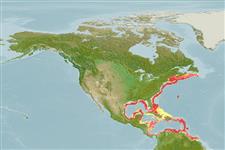Common names from other countries
Teleostei (teleosts) >
Eupercaria/misc (Various families in series Eupercaria) >
Latilidae (Deepwater tilefishes)
Etymology: Lopholatilus: Greek, lophos = crest + Latin, latus = wide (Ref. 45335).
More on authors: Goode & Bean.
Environment: milieu / climate zone / depth range / distribution range
Ecology
Marine; demersal; depth range 80 - 540 m (Ref. 5217). Subtropical; 9°C - 14°C (Ref. 33985); 46°N - 5°N, 98°W - 53°W
Western Atlantic: Nova Scotia, Canada south along the U.S., Gulf of Mexico from the Florida Keys, Tampa (Florida) to the Texas/Mexico border, and off Mexico from Tabasco to the Yucatan Peninsula, and along South America from the Gulf of Cariaco (Venezuela) to Suriname (R. Robertson and J. Dooley pers. comm. 2013).
Length at first maturity / Size / Weight / Age
Maturity: Lm 42.2 range ? - ? cm
Max length : 125 cm TL male/unsexed; (Ref. 3276); 95.0 cm FL (female); common length : 90.0 cm TL male/unsexed; (Ref. 3276); max. published weight: 30.0 kg (Ref. 9988); max. reported age: 35 years (Ref. 6086)
Most common around 200 m, usually over mud or sand bottom and occasionally over rough bottom (Ref. 9988); prefers temperature of 8-17°C (Ref. 5951). Feeds mainly on shrimp and crabs, but also takes fish, squid, bivalves and holothurians. Sensitive to cold water (Ref. 9988), a mass die-off occurred in 1882, after which the species was rare for decades, presumably due to unusually cold water (Ref. 7251). Marketed fresh or frozen; can be steamed, pan-fried, broiled, microwaved and baked (Ref. 9988).
Dooley, J.K., 1978. Branchiostegidae. In W. Fischer (ed.) FAO species identification sheets for fishery purposes. West Atlantic (Fishing Area 31). Volume 1. FAO, Rome. (Ref. 3276)
IUCN Red List Status (Ref. 130435)
CITES (Ref. 128078)
Not Evaluated
Threat to humans
Harmless
Human uses
Fisheries: commercial; gamefish: yes
Tools
Special reports
Download XML
Internet sources
Estimates based on models
Preferred temperature (Ref.
115969): 6.6 - 22.3, mean 16.2 (based on 108 cells).
Phylogenetic diversity index (Ref.
82804): PD
50 = 0.7500 [Uniqueness, from 0.5 = low to 2.0 = high].
Bayesian length-weight: a=0.00776 (0.00407 - 0.01480), b=3.11 (2.93 - 3.29), in cm Total Length, based on LWR estimates for this species & (Sub)family-body (Ref.
93245).
Trophic level (Ref.
69278): 3.9 ±0.2 se; based on diet studies.
Resilience (Ref.
120179): Low, minimum population doubling time 4.5 - 14 years (K=0.09-0.13; tm=5; tmax=35; Fec=195,000).
Fishing Vulnerability (Ref.
59153): High to very high vulnerability (73 of 100).
Climate Vulnerability (Ref.
125649): Moderate vulnerability (38 of 100).
